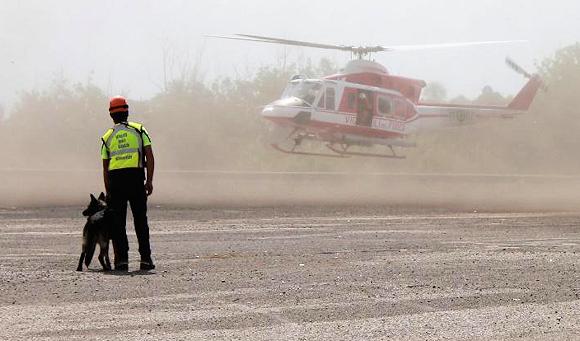Habit kills emotions. Not when it flies.
"Whoever has tried the flight, will walk in the sky, because there has been and there he wants to go back" (Leonardo da Vinci).
The intention is not to surrender to the rhetoric of quotations, because on board an AB-412 of the Fire Helicopter Helicopter Center, one realizes that the airplane is a multiplier of forces.
The helicopters belong to the Specializations of the National Fire Brigade Body (CNVVF). The first helicopter core was born in 1954 in Modena. To date, they are distributed throughout the country. They carry out on average rescue missions: the most frequent, rescue of people in particular conditions of danger, road accidents, reconnaissance, fire extinguishing by the use of hookah equipment, search for dispersed persons with TAS operators (Topography Applied to Rescue ), animal rescue and recovery etc. The use of helicopters allows to overcome a great deal of difficulty during rescue operations and assistance to isolated settlements in natural disasters: the screen effect. It consists of the conformation that takes the distribution of the damage produced by the event. Broken roads, landslides, collapses, bridges, communication systems that, when they do not work, limit and obstruct the intervention of ordinary VVF teams that by means of vehicles head to the affected areas to help. The risk is that the delay in aiding affects the ability to save survivors. Helicopters for their speedy intervention are a useful aide to ground teams: you have the chance to reach the heart of the otherwise inaccessible area, avoiding the "outside" screen.
 The VVF flight departments possess several types of helicopters, depending also on the area of competence: from Erickson coming from the State Forestry Corps to A109 up to Canadair included in the air fleet. The helicopter types, usually supplied, are the AB206 Jet Ranger III and the AB412 EP. The latter with its double engine, with a rescue winch and its large cabin with double commands with 2 pilot seats, can be reconfigured depending on the operational needs of emergency technical assistance.
The VVF flight departments possess several types of helicopters, depending also on the area of competence: from Erickson coming from the State Forestry Corps to A109 up to Canadair included in the air fleet. The helicopter types, usually supplied, are the AB206 Jet Ranger III and the AB412 EP. The latter with its double engine, with a rescue winch and its large cabin with double commands with 2 pilot seats, can be reconfigured depending on the operational needs of emergency technical assistance.
The radio callsign of the Fire Brigade helicopters is "dragon"
Each helicopter core has a starting crew consisting of a pilot pilot, a second pilot, 2 airstrike aircraft, and a welder technician who manages the winch to "lower" the specialists and / or to save people, creeps and crevices, or to recover works of art during collapse, earthquakes etc. Within the helicopter cabin you can carry up to 15 people altogether.
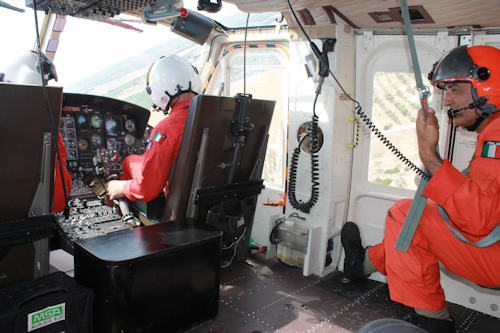
The rescue plan is first of all a firefighter. It is a professional figure trained to recover people in difficulty in different contexts (sea, mountain, complex sites to reach). The main tasks are the first aid to stabilize traumatized, search and rescue of dispersed both on land and at sea. In the training course, the four SAF operating levels (1a, 1b, 2a, 2b), the "fluvial-alluvial" SAF and the TPSS sanitary aid course have been positively exceeded. Many also qualify as Aquatic Rescue. In addition to ordinary training activities, VF rescue planes perform monthly exercises to maintain their training level. The AB 412 EP helicopter aboard staff is on duty on 365 days a year.
In situations of real emergency, both the affiatamento and the continuous exchange of information between the pilots, the winch and the rescue aircraft are fundamental. Experience and time contribute to making these highly specialized crews. The main dangers for VVF helicopters, which work at low altitude, are cables and adverse weather conditions that compromise visibility.
From dawn to dusk, each helicopter core is ready to take off every day on rescue missions at the request of the Regional Departments and Provincial Commands, to operate in operating theaters that require the operation of the aircraft.
All firefighting teams, trained for rescue in various situations, can be transported on land, nautical and aircraft. With helicopters, it is possible to quickly move the various specialized nuclei in relief such as the SAF nuclei (Speleo Alpino Fluviale), the Divers and Kennelclubs.
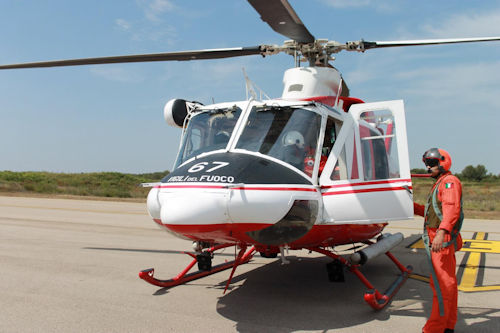
Teams, pilots, specialists, coordination and control centers depend on an organization that establishes strategies and priorities for each sector. This modus operandiwithout the need for additional organizations, automatically, systematically and functionally guarantees an immediate response with every resource from the National Fire Brigade Body.
The unique and integrated organization of CNVVF is due to specific plans, exercises and training.
Due to the different types of rescue intervention and the unpredictability with which emergencies may occur, CNVVF employs the various scenarios, both specializations (Air Rescue, Nuclear Divers, Ports and Radial Repairs) and high qualifications (Aquatic Rescue surface, SAF Core, Aerospace, NBCR or Nuclear, Biological, Chemistry and Radiology, Cinofile Core, GOS - Earth Movement and Usar - Urban Search and Rescue).
Waiting for "Dragon 67" on the airport track, there are the Kinofili Nuclei of the VVF of Apulia and Abruzzo. Throughout the mornings, a joint exercise is being conducted between the CWD units and the VVF's "red suits" special core.
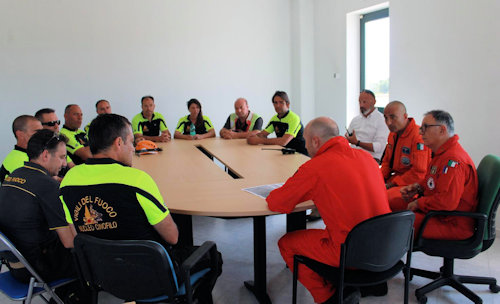 You start with a briefing on the training activity for approaching the canine units to the helicopter. You decide on the Operational Safety Plan (POS): risk assessment and certain protection measures to be tested in this specific training phase. The dog aboard the AB412 must be secured through a length of a certain length and a carabiner at the seat of its conductor.
You start with a briefing on the training activity for approaching the canine units to the helicopter. You decide on the Operational Safety Plan (POS): risk assessment and certain protection measures to be tested in this specific training phase. The dog aboard the AB412 must be secured through a length of a certain length and a carabiner at the seat of its conductor.
This procedure avoids any loss of control by the driver of the same dog who must not obstruct the activity of the pilot cabin, compromising the safety and stability of the vehicle and personnel on board. It is also possible to use the carrier to house the dog inside the helicopter. There is no obligation for the use of the muzzle even if all the conductors of the dog units are in possession of it.
The task to be done is to check the procedures for boarding and disembarking of each operating unit with the engine off, then with a powered engine and finally a flight circuit for a few minutes. It is necessary that the dog "familiarize" with the helicopter in the approach to the engine off. Later, when the engine is switched on and the flight of a few minutes increases (due to the "noise" of the blades of the AB 412) the hearing and olfactory difficulties for the dogs (the same blades increase the movement of the air currents) . From approaching the ascent of the helicopter to the flying circuit, the feeling between dog and driver is put to the test, like the will, obedience and commitment of the dog itself to overcoming any obstacles.
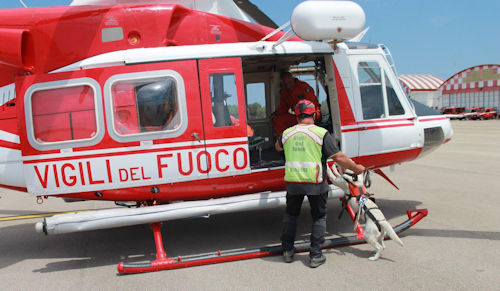 Just a glance, a nose with a head, a caress on the back, and all dogs perform the exercise without any difficulty. Molly, a honey-colored Labrador, appreciated the second flight circuit before descending from the AB412.
Just a glance, a nose with a head, a caress on the back, and all dogs perform the exercise without any difficulty. Molly, a honey-colored Labrador, appreciated the second flight circuit before descending from the AB412.
It is up to both the national instructor of the Cowardly VVF Nuclei of Apulia and Abruzzo, Oronzo Passabì, and the conductor to evaluate the behavior and conduct of her dog at all stages of the exercise. The activity also serves to prepare the conductors as well as their "colleagues" at 4 feet uphill and downhill from the helicopter with timely emergency.
VVF cymbals are used with specialist components such as helicopters for emergency technical assistance, in-person research in the case of avalanches, landslides, and the search for scattered on the surface and under the rubble. The time duration of the cowhide operations varies from 1 to 5 days. The essential purpose of unit work is to help people find out when this is possible or, in the most unfortunate cases, to find the body of the missing for a worthy burial. They can also be sent abroad in the context of international relief operations.
Dogs are periodically trained in well-equipped areas, by their technical guides (conductors): they move on impermeable terrain, they enter into tunnels, ditches or unmanned tunnels. VVF dogs are owned by the same and the methods used for training are not coercive against the dog,
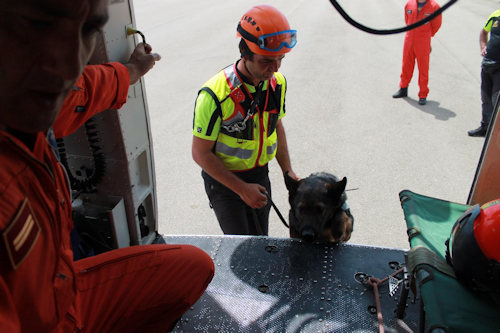 You are using specific exercises or for the work you do is rewarded with your favorite game or with food.
You are using specific exercises or for the work you do is rewarded with your favorite game or with food.
The first cinnamon core dates back to 1939, set up for the search for the missing ones under the rubble because of bombings. It also included the training center, trial fields, and a breeding section for the puppy section. Released at the end of the war period, in the 90 years, the VVF cynophilic nucleus was reorganized with the establishment of the National School of the Cinefile Unit of Volpiano (To), where selections and training courses are currently being carried out.
The qualification of canine can be achieved by both permanent and voluntary staff only after passing a specific training course and after verifying the existence of the psychophysical and aptitude requirements of the dog to carry out the rescue activity. It should be pointed out that volunteer staff can turn to volunteer service according to turnaround or volunteers who offer a daily or operational discontinuous service (from here VVF Discontinui) to the Provincial Commands, Regional Departments, training schools or all other offices within the VVF Department. Former voluntary auxiliary volunteers are officially registered in the provincial command lists (art.12 of the 8 Dec. 1970 law, n. 996).
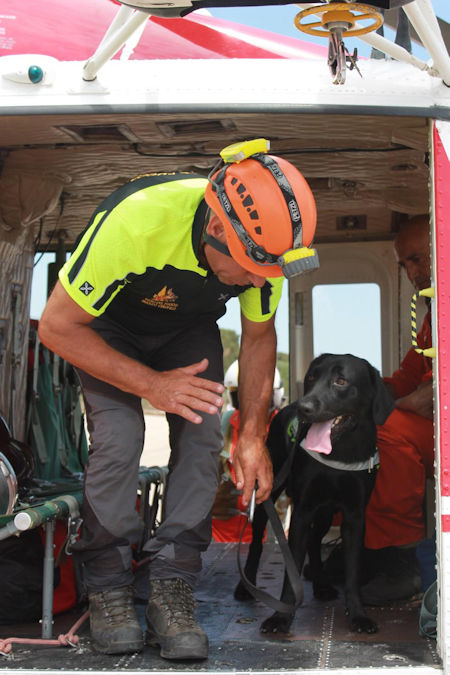
The activation of the personnel available for each cinefilo core established on national territory is by contacting the operating room of the VVF Provincial Commanders responsible for territory via the 115 rescue number: the cinefile units must be alerted to reach their service center over time as short as possible. Dog use reduces the time to find people still alive, especially in areas that are difficult to survive, increasing the likelihood of rescuing missing people. If this is an unacceptable area or difficult to reach even with off-road vehicles, all canoes can be boarded on helicopters to be transported immediately to the area of intervention.
All emergency calls as per European regulations will soon come into a Unique Response Center (CUR) NUE 112 (Unique Emergency Number 112): any emergency phone number the caller has made, including the unique number. NUE112 is used to contact emergency services in the EU, and is partially active in some EU countries. In Italy he is active in Lombardy, Piedmont, Liguria, Friuli Venezia Giulia, Aosta Valley, Trentino Alto Adige, Lazio (district 06) and in several Sicilian provinces.
In addition to the boarding and disembarkation training, the canine units will also be trained to be dumped with a winch by an over helicopter, simulating how in reality a search.
Such training activities guarantee at national level a significant and profitable interaction between all the nucleus nuclei and all the helicopter nuclei of the VVF permitting the starting crews to know the operation of each nucleus and of the individual canine units (conductor - dog ).
At the end of the exercise, the debriefing discussed the adopted operating methods and the execution of the tests by all the canine units. Just the time of pre-flight checks and the AB412 took off from the airport track.
"It was what others did not want to be, I went where the others did not want to go, I ended what others did not want to do [...] I saw the face of terror, I felt the cold bitten by fear, I rejoiced for the sweet taste of a moment of love ..."(a firefighter).
Also read: "Fire Brigade, Ancient History"
Also read: "Fire Brigade: selection, means, organization and training"
Also read: "Core Cowboys Firefighters: training in a rubble field"

(photo of the author)

